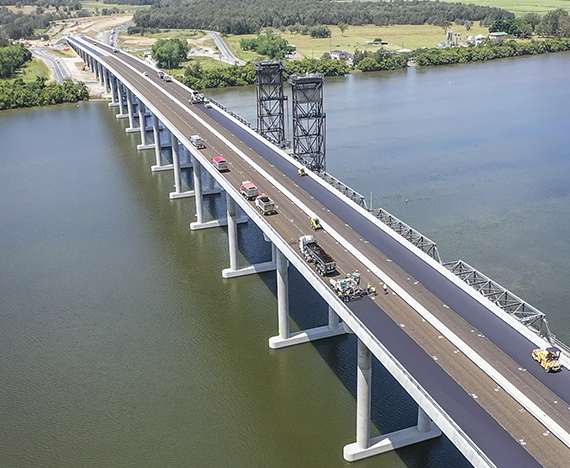- Australia
- Go to acciona.com
1.52km
over the Clarence river
INDUSTRY, INNOVATION AND INFRASTRUCTURE
Build resilient infrastructure, promote sustainable industrialization and foster innovation
Economic growth, social advancement and action against the climate emergency depend largely on investment in infrastructure, sustainable industrial development and technological progress. Today, about 1 billion people live more than 2 km from a roadway, 940 million live without electricity, and 663 million lack improved drinking water sources.
ACCIONA participates in the entire infrastructure construction value chain, from the identification of opportunity, design and execution, to the operation and maintenance of the constructed works, using the most advanced and innovative techniques.
Performance quality and safety are two of the criteria that maximize the company's value proposal in the development of large infrastructure projects and that differentiate it from other competitors in the construction field.
Design and construction of a new 1.52 kilometre bridge over the Clarence River, about 30 metres downstream of the existing bridge. The stretch of the bridge over the Clarence River is 620 metres, with a minimum height over the river of 30 metres to allow the passage of maritime traffic.
CURRENT STATUS
The new Clarence River bridge in Harwood, designed and built by ACCIONA together with Ferrovial, opened to traffic on 5 December 2019 after the sections adjacent to the new bridge were completed.
The new bridge is 1.5 kilometres long and has been designed to preserve the much admired heritage of the existing bridge. Its aligned piers and height reflect the height of the existing bridge's lift bridge. It provides safer, smoother travel for motorists and eliminates the need for motorists to stop while the existing bridge is raised for maritime users.
The contract to design and construct the new bridge was awarded to an ACCIONA and Ferrovial joint venture in July 2016 for an estimated AUD 250 million (EUR 154 million).
The new bridge has been constructed from 144 innovative "U" shaped beams that require 30 % less concrete compared to "T" shaped beams. The beams, each weighing 168 tonnes, were safely installed using complex manoeuvres. A 750 tonne crane operating from a barge on the river was used to install the last 48 beams that make up the bridge.
The design and construction of the new bridge is part of the Woolgoolga to Ballina Pacific Highway upgrade. The project is jointly funded by the Australian and NSW governments.
As part of the wider Pacific Highway upgrade, ACCIONA, once again in a consortium with Ferrovial, built a 19.5 kilometre section of road between Warrell Creek and Nambucca Heads. This section of road opened to traffic in 2018.
GENERAL INFORMATION
- Location: Harwood, New South Wales, Australia.
- Contract type: Design and construction.
- Infrastructure: Design and construction of a 1.5 km single deck bridge.
- Year of project completion: End of 2019
KEY ASPECTS
- The project is part of the larger AU $4.36 billion Woolgoolga to Ballina Pacific Highway upgrade and is jointly funded by the state and federal governments.
- The upgrades will improve road safety, reduce travel times and increase transport efficiency.
- The design allows for the navigation of vessels up to 30 metres high.
- 1.52 kilometre, 35 span dual carriageway bridge.
- 620 metre length over the river.
- 30 metre vertical clearance above the river.
- 20 metres east of the existing Harwood Bridge.
- 117 marine and land piles.
- 35 piers – 13 in the Clarence River and 22 on land.
- 144 concrete bridge girders weighing up to 168 tonnes each.
- All girders built at on-site precast yard.
RELATIONSHIP WITH THE COMMUNITY
Due to the proximity between the facilities needed to build the beams and neighbouring houses, noise and vibration control measures were put in place to minimise impact.

A special social media campaign was developed consisting of six publications to inform road users and the local community about the work. It involved technical experts from the project team with video images to explain the work and the closures in more detail. Other ways to keep the community informed as the project progressed included:
- Four major press releases.
- Occasional newsletters.
- Construction notices.
- Project updates.
This information was distributed to some 125 residents and the community at large on a regular basis. The project team regularly attended information points at local markets and shopping centres that provided the community with the opportunity to ask questions and find out more. Regular meetings and updates were also held with key stakeholders, including the Professional Fishermen's Association (the local shrimping and fishing industry), Harwood Sugar Mill and the Clarence Valley Council.
Technology, innovation and sustainability
"Spider" pumping arm
A "Spider" pumping arm was used to pour concrete into the sections over the river where access is restricted.
This is a type of concrete pumping that can be installed in a static location adjacent to the pouring area, and provides a working radius of up to 25 m. Concrete is pumped to the spider arm using a traditional pump and a static line. The use of the spider arm eliminated the manual handling problems associated with the use of a static line on the ground to deliver and place concrete.
